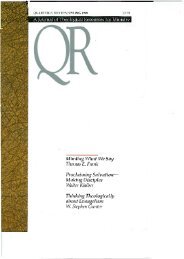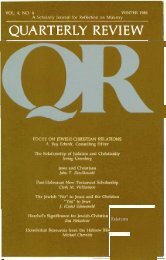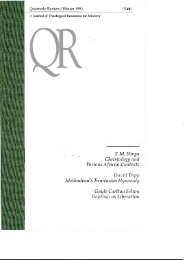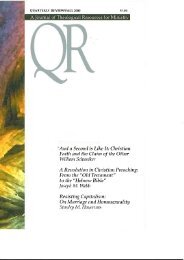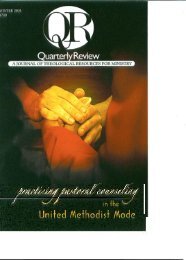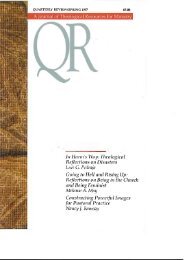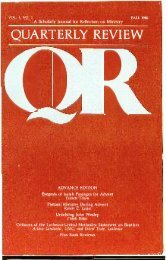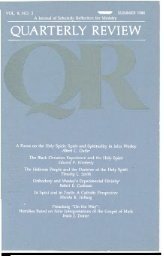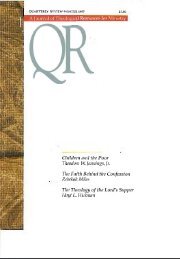TJieodore W. Jennings, Jr. The Meaning of ... - Quarterly Review
TJieodore W. Jennings, Jr. The Meaning of ... - Quarterly Review
TJieodore W. Jennings, Jr. The Meaning of ... - Quarterly Review
You also want an ePaper? Increase the reach of your titles
YUMPU automatically turns print PDFs into web optimized ePapers that Google loves.
particular way. <strong>The</strong> particularity <strong>of</strong> the letter form corresponds to<br />
the scandalous particularity (not to be confused with<br />
"individualism") <strong>of</strong> the Christian faith.<br />
More than Personal Communication. Both letters are written by<br />
church leaders to congregations <strong>of</strong> Christian people, but both<br />
represent more than a personal communication from one individual<br />
<strong>The</strong> UCCCD letter bears the signature <strong>of</strong> a single member <strong>of</strong> the<br />
congregation, the campaign chairperson, Denny Alexander.<br />
Although this letter was composed primarily by one person, it was<br />
the result <strong>of</strong> the committee process, with the names <strong>of</strong> the entire<br />
committee appearing on the letterhead. This letter represents not just<br />
an individual but the church. We are familiar with this accepted<br />
form <strong>of</strong> communication, including documents that are entirely the<br />
work <strong>of</strong> a committee sent "over the signature" <strong>of</strong> its chair or some<br />
other individual. No one called the church <strong>of</strong>fice and inquired<br />
whether the letter was composed entirely by the person whose<br />
signature it bore. <strong>The</strong> question was whether or not it represented the<br />
church.<br />
First Peter was long assumed to have been written by the Apostle<br />
Peter, whose name it bears as its first word. But we now know that<br />
in the first century it was common to compose letters in the name <strong>of</strong><br />
well-known leaders in order to perpetuate their message. <strong>The</strong> vast<br />
majority <strong>of</strong> scholars who have studied 1 Peter critically have<br />
concluded that it is such a pseudonymous letter. 4<br />
<strong>The</strong>re is an important connection with Simon Peter, however,<br />
which may be outlined as follows: 5<br />
a. <strong>The</strong>re was a real person named Simeon ("Simon"), a man in<br />
the fishing business in Galilee, who had known the human Jesus<br />
personally and had been called by Jesus during his lifetime to be an<br />
apostle. Jesus renamed him "Cephas," Aramaic for "rock," which<br />
is "Peter" in Greek. He had his ups and downs as a disciple and<br />
finally denied and rejected Jesus at the time <strong>of</strong> his arrest.<br />
b. <strong>The</strong> risen Jesus appeared to Peter, reconstituted him as an<br />
apostle, and Peter became a leader in one wing <strong>of</strong> the new Christian<br />
community, the somewhat conservative Jewish-Christian wing,<br />
which looked back to the earthly Jesus and communicated the faith<br />
by handing on his sayings and told stories about him.<br />
c Peter and his wife, whose name we do not know (1 Cor. 9:5),<br />
traveled about as a missionaries. Peter finally made his way to<br />
INTERPRETING 1 PETER AS A LETTER 91



